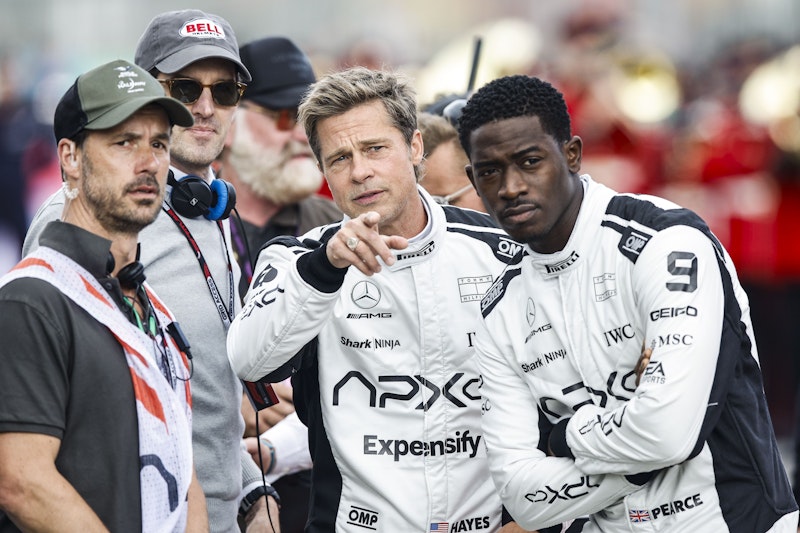Director Joseph Kosinski’s 2010 legacy sequel Tron: Legacy wasn’t a notable film, other than the fact that it was (at the time) the most expensive directorial debut of all-time. While Kosinski’s name isn’t listed among the greatest working directors, his ability to impose classical blockbuster storytelling on expensive, boundary-pushing technical productions hasn’t gone unnoticed. Kosinski’s greatest achievement is Top Gun: Maverick, the long-anticipated sequel that surpassed Tony Scott’s 1986 classic. Kosinski’s latest film, F1, is essentially an homage to Days of Thunder, the racing film that Scott and Tom Cruise made immediately after Top Gun.
Days of Thunder may have been about NASCAR, but it shares the same DNA with F1. Both films are about a defiant, daredevil racer whose willingness to put himself in danger puts pressure on his team, owners, and sponsors. Although Brad Pitt’s character, Sonny Hayes, is an original creation, he’s a protagonist with a pre-established history. After a few quick allusions to a distressing incident during his early career, it's evident that Sonny has sought an opportunity to get back in the good graces of the public with an uncontested victory. In F1, Sonny’s only chance at a comeback is to team up with the rising star Joshua Pearce (Damson Idris), endorsed by his lifelong friend (and APXGP team owner) Ruben Cervantes (Javier Bardem).
It’s a blatant allusion to Pitt’s own star status, who despite winning an Oscar for his work in Once Upon A Time in Hollywood, has appeared in many flops in the past five years, some interesting (Babylon, Ad Astra), and some not (Wolfs, The Lost City). Pitt’s best work is often in films like Tree of Life or Fight Club, where he’s allowed to make eccentric choices. However, F1 is a throwback to a 1990s era of blockbusters, where movie stars needed to be suave, spunky, and only slightly dangerous. While Pitt is one of the few names that could have justified a production like F1 (rumored to cost well over $200 million), he’s given the opportunity to depict Sonny as aggressive, antagonistic, and unpredictable when given the reins to an expensive property. The “think pieces” will certainly be numerous, given the recent controversies about Pitt’s personal life; in addition to a physical brawl with a teammate, Sonny’s actions in F1 include a confrontational relationship with a member of the press that had pried into his past.
Pitt and Idris are ultimately tools in service of the real star of F1, which is the extraordinary racing sequences. Given that the film was produced in conjunction with Mercedes-AMG F1 team and Carlin Motorsport teams, given access to Formula One pundits and tracks, and shot on location at the 2024 24 Hours of Daytona (among other official events), it's hard to be shocked at the glaring product placement. Nonetheless, F1 isn’t so devoted to the brand that it's devoid of criticism, as the dangers of the sport are depicted frequently, and with a surprising amount of violence for a PG-13 film.
The clunkiness of the film’s screenplay, which has several repetitive character beats, may be a result of how dependent it is on the precision of the racing scenes. Kosinski has knowledge of what angles can heighten the suspense, when to shift into a montage, and how to incorporate the pit crew, onlookers, and media announcers into the action. Similar to the faceless villains in Top Gun: Maverick, the rival drivers are never depicted in F1. Although its constantly reiterated that Formula One is a “team sport,” Kosinski understands it's a sport designed for those that can’t relate to others.
The question that F1 has asked is about the type of person that would be drawn to an event like this. Although the incident in Sonny’s past may give some context, his character is framed as someone who’s unwilling to let himself rest easily. Relationships that aren’t related to his overarching goal are superfluous to Sonny, an idea strengthened by the reveal that he lost his father when he was a teenager. It’s not surprising that Sonny’s dynamic with Pearce is an obvious case of “adversaries turned allies,” but F1 is able to depict their mutual understanding without either characters’ edges being sanded off.
The machinations behind Sonny’s revival aren’t particularly interesting, as he’s hired as a result of a last resort on Ruben’s part; with his board threatening to buy him out if he has another season without a victory, Ruben is given no choice but to rely upon someone with nothing left to lose. There’s some legal scheming from the APXGP board member Peter Banning (Tobis Menzies) that’s detrimental to the pacing, but Sonny’s familiarity with the fundamentals of racing is perfect for the film’s exposition. While he has a history of racing disciplines (including NASCAR, Autocross, and Drifting), his minimal experience with modern Formula One is the excuse the film needed to explain the sport’s rules and regulations to casual viewers.
Kerry Condon’s Kate McKenna, APXGP’s technical director, is introduced as a spitfire who is forced to keep Ruben and his drivers in check, but her fastidiousness is gradually eroded by the time she’s turned into Sonny’s love interest. Granted, a film that’s as grounded in the archetypes of the Bruckheimer generation was never going to be particularly progressive, but Condon’s overqualified for a role in which she’s asked to constantly fawn over Pitt. Nonetheless, Kate and Ruben provide some emotional engagement in a film that’s centered on stoic obsessives.
There would be little point in a modern racing film if it didn’t push the boundaries of spectacle, but it’d be unwise to mess with an established narrative formula that’s existed since Steve McQueen was behind the wheel of a Porsche. Nonetheless, F1 is significantly more watchable than a majority of the franchise-oriented fare this summer.

